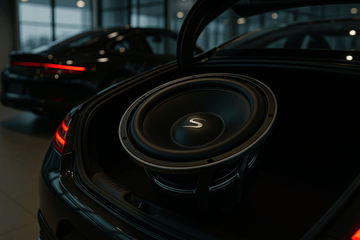Today, car audio systems have become more advanced and sophisticated, allowing drivers and passengers to enjoy a superior audio experience. Car subwoofers, in particular, play a vital role in enhancing the audio quality by delivering deep, powerful bass. However, the materials used in subwoofer construction can significantly impact their performance, durability, and overall sound quality. In recent years, lightweight subwoofer materials have gained popularity, offering numerous benefits without compromising audio performance.
In this blog, we will explore the importance of lightweight subwoofer materials for cars, their impact on sound quality and vehicle performance, and the different types of materials available in the market. So, let's dive in and discover the world of lightweight subwoofer materials that can elevate your car audio experience.
Learn the science behind the sound. Delve into the technicalities with our Car Subwoofer Materials guide.
Understanding Car Subwoofers
Car subwoofers are an integral component of any car audio system. Their primary purpose is to reproduce low-frequency sound, particularly bass. Car subwoofers are responsible for providing deep, rich bass notes that add depth and impact to the audio experience. By accurately reproducing bass frequencies, subwoofers contribute to a more immersive and engaging driving sound experience. These specialized audio devices work with car audio amplifiers and speakers to deliver exceptional audio performance, enabling listeners to enjoy their favorite music or audio content with enhanced clarity and power.
Purpose of Car Subwoofers
Car audio enthusiasts understand the significance of subwoofers when creating a high-quality car audio system. The purpose of a car sub is to reproduce low-frequency audio signals, primarily bass, which are crucial for achieving a balanced and immersive sound experience. Car audio systems may sound lacking or incomplete without subwoofers, especially in bass reproduction. Subwoofers focus on bass frequencies, allowing car audio systems to achieve a more excellent dynamic range, resulting in a more full-bodied sound.
Car subwoofers are designed to handle and reproduce low-frequency audio signals that regular car speakers may struggle to produce accurately. They are engineered to deliver deep bass tones with precision and power, ensuring that listeners can fully appreciate the low-end audio content in their favorite music genres. Car subwoofers are essential for achieving high-quality car audio sound, providing a richer, more immersive driving experience.
How Car Subwoofers Work
Car subwoofers utilize advanced audio technology to produce deep, resonant bass sounds. They generate sound waves at low frequencies, typically below 100 Hz, then reproduced through the subwoofer driver. These drivers are designed to handle bass frequencies, allowing for accurate and powerful bass reproduction.
To ensure optimal performance, car subwoofers are typically paired with car audio amplifiers. The amplifier provides the necessary power to drive the Subwoofer, enabling it to produce impactful bass tones. The amplifier ensures that the Subwoofer receives sufficient electrical power to reproduce bass frequencies accurately and at the desired volume.
Subwoofers are commonly housed in specialized enclosures, often called subwoofer boxes. These enclosures ensure proper sound reproduction, enhance bass response, and minimize distortion. The subwoofer box design and construction materials are essential to producing high-quality audio.
Can lightweight subwoofer materials withstand high volume levels?
Yes, lightweight subwoofer materials for cars are designed to withstand high volume levels. These materials are specifically engineered to be strong and durable, allowing them to handle the vibrations and pressure generated by high audio volumes without compromising sound quality or structural integrity.
Importance of Lightweight Subwoofer Materials
The weight of subwoofer materials is crucial in-car audio systems, impacting performance and portability. Lightweight subwoofer materials offer several advantages over their heavier counterparts, making them increasingly popular among car audio enthusiasts. They contribute to improved vehicle performance, enhance sound quality, and provide convenience during installation.
Lightweight subwoofer materials strike the perfect balance between audio performance and portability, ensuring that car audio systems can deliver optimal sound quality without compromising other aspects of the vehicle.
Benefits of Lightweight Subwoofers
Lightweight subwoofers offer numerous benefits, making them a preferred choice for car audio enthusiasts. Here are some of the advantages of using lightweight subwoofer materials:
- Enhanced Vehicle Performance: Using lightweight materials in subwoofer construction reduces the added weight, improving fuel efficiency and overall vehicle performance.
- Improved Handling: With reduced weight, lightweight subwoofers have minimal impact on the vehicle's handling characteristics, allowing for a more balanced driving experience.
- Easier Installation and Handling: Lightweight materials make subwoofers easier to handle and install, reducing the complexity and time required for setup.
- Optimal Sound Quality: Lightweight subwoofer materials are designed to minimize resonance and distortion, resulting in more precise, more defined bass reproduction.
Impact on Sound Quality
The materials used in subwoofer construction have a direct impact on sound quality. When chosen appropriately, lightweight subwoofer materials can improve audio clarity and accuracy and reduce distortion. Using materials that dampen unwanted resonance, lightweight subwoofers can reproduce bass frequencies with greater precision, resulting in a more balanced and immersive sound experience.
The design and construction of the subwoofer box, using lightweight materials such as MDF (medium-density fiberboard), plywood, or other advanced composites, further enhances sound quality by minimizing box resonance and maximizing bass response. Overall, lightweight subwoofer materials significantly influence the sound quality of car audio systems, ensuring listeners can enjoy a more enjoyable and immersive audio experience while on the road.
Effect on Vehicle Performance
Using lightweight subwoofer materials has minimal impact on vehicle performance. Unlike heavier materials, lightweight subwoofer materials reduce the added weight, improving fuel efficiency and overall vehicle handling. This is particularly important for car audio enthusiasts who prioritize audio quality without sacrificing their vehicle's performance.
By choosing lightweight materials, car audio systems can deliver exceptional sound quality while maintaining the desired performance level of the vehicle. Lightweight subwoofer materials ensure the audio amplifier receives sufficient power to drive the Subwoofer effectively without overtaxing the vehicle's electrical system. The combination of lightweight materials and efficient amplifier utilization allows for a harmonious balance between audio performance and vehicle functionality, providing car audio enthusiasts with the best of both worlds.
Types of Lightweight Subwoofer Materials
Several types of lightweight subwoofer materials are available in the market, each offering unique characteristics and benefits. Let's explore some of the commonly used lightweight subwoofer materials:
Polypropylene Subwoofers
Polypropylene subwoofers are renowned for their lightweight construction and durability. These subwoofers are designed to withstand the rigors of car audio systems, providing long-lasting performance without adding unnecessary weight. Polypropylene subwoofer materials offer excellent sound quality, delivering deep, impactful bass notes without compromising clarity or accuracy. Their lightweight nature makes them ideal for car audio installations, allowing for easier handling and installation. Polypropylene subwoofers balance durability, performance, and portability, making them popular among car audio enthusiasts.
Kevlar Subwoofers
Kevlar subwoofers are known for their exceptional strength, durability, and sound quality. Using Kevlar, a potent synthetic fiber, in subwoofer construction ensures that these subwoofers can handle high-power audio signals while maintaining structural integrity. Kevlar subwoofer materials enhance sound resonance, producing precise, accurate bass reproduction. While offering durability, Kevlar subwoofers are lightweight, making them suitable for car audio systems that prioritize audio quality, reliability, and portability.
Carbon Fiber Subwoofers
Carbon fiber subwoofers are revered for their lightweight yet durable enclosure materials, making them popular among car audio enthusiasts. Using carbon fiber in subwoofer box construction ensures unsurpassed sound resonance, producing exceptional bass performance and sound quality. Carbon fiber subwoofers are renowned for reproducing low-frequency audio signals with outstanding accuracy, enabling listeners to enjoy deep, impactful bass notes. These subwoofers strike the perfect balance between lightweight materials and enclosure rigidity, making them an excellent choice for car audio systems that demand superior sound quality.
Aluminum Subwoofers
Aluminum subwoofers are characterized by their durable enclosure materials, making them an ideal choice for car audio systems. Using aluminum ensures that these subwoofers are lightweight and structurally sound, contributing to enhanced sound quality. Aluminum subwoofer enclosure materials provide excellent sound resonance, reproducing deep, punchy bass. These lightweight subwoofers are crafted precisely, ensuring optimal sound quality and durability for car audio systems. Aluminum subwoofers are preferred among car audio enthusiasts who value audio performance, portability, and quality construction.
Comparing Different Lightweight Subwoofer Materials
With various lightweight subwoofer materials available, it's essential to understand their distinctive characteristics and how they impact audio performance. Let's compare some of the commonly used lightweight subwoofer materials:
Durability and Strength
When comparing different lightweight subwoofer materials, durability and strength are crucial factors. Here's a comparison of their characteristics:
- Polypropylene Subwoofers:
- Lightweight and durable, suitable for car audio installations
- Resistant to moisture, heat, and UV rays, ensuring long-lasting performance
- It provides excellent bass reproduction with minimal distortion
- Kevlar Subwoofers:
- Exceptional strength and durability, capable of handling high-power audio signals
- Offers enhanced sound resonance for precise, accurate bass reproduction
- Lightweight design, making them suitable for car audio systems
- Carbon Fiber Subwoofers:
- Lightweight yet durable enclosure materials
- Unparalleled sound resonance, resulting in exceptional bass performance
- Delivers outstanding audio quality, reproducing bass frequencies with accuracy
- Aluminum Subwoofers:
- Lightweight construction, ideal for car audio systems
- It provides excellent sound quality and bass reproduction
- Durable enclosure materials ensure long-lasting performance
Sound Resonance
Sound resonance is critical when comparing different subwoofer materials, as it directly impacts sound quality and bass performance. Here's how different lightweight subwoofer materials contribute to sound resonance:
- Polypropylene Subwoofers minimize resonance and distortion, enabling listeners to enjoy more apparent, defined bass notes.
- Kevlar Subwoofers: Kevlar subwoofer materials offer superior sound resonance, resulting in accurate bass reproduction and improved audio quality.
- Carbon Fiber Subwoofers: Carbon fiber subwoofer enclosure materials provide unmatched sound resonance, ensuring superior bass and sound quality.
- Aluminum Subwoofers: Aluminum subwoofer materials contribute to excellent sound resonance, enhancing bass performance and sound quality.
- Sound resonance is crucial in achieving a balanced, natural, and immersive sound experience in car audio systems. By carefully considering subwoofer materials, listeners can enhance their audio quality and enjoy a more enjoyable and immersive sound experience on the road.
Selecting the Right Lightweight Subwoofer for Your Car
When selecting the right lightweight Subwoofer for your car audio system, several factors must be considered. From subwoofer size to power requirements, making an informed decision ensures optimal audio performance. Let's explore critical considerations when selecting a lightweight subwoofer for your car.
Considering the size of the Subwoofer
The size of the Subwoofer is an important consideration when selecting one for your car audio system. Here's why:
- Fit and Performance: The size of the Subwoofer determines how well it integrates into the car audio setup. It should fit comfortably in the available space, ensuring optimal audio performance.
- Bass Response: The size of the Subwoofer directly affects bass response. Larger subwoofers can generally produce more profound, more impactful bass notes. However, the car's available space must also be considered.
- Consider the available space and your desired bass response when assessing the size of the Subwoofer, ensuring it seamlessly integrates into your car audio system, providing the desired audio experience.
Considering the Power Requirements
Understanding the power requirements of subwoofers is crucial for achieving optimal audio performance in your car. Here's why:
- Performance and Efficiency: Power requirements dictate the performance and efficiency of subwoofers within car audio systems. Matching the power handling capabilities of the Subwoofer with the amplifier ensures optimal performance and sound quality.
- Compatibility: Consider the power handling capabilities of subwoofers to ensure they are compatible with your amplifier. Mismatched power requirements can result in poor audio quality and potentially damage the Subwoofer or amplifier.
- When selecting subwoofers, consider their power requirements, ensuring they align with your amplifier's capabilities. This ensures the Subwoofer operates at its best, delivering impactful bass and optimal audio performance in your car.
Considering the Price Range
Price range considerations are essential when selecting a subwoofer that meets your car's audio needs. Here's why:
- Budget: Understanding the price range of subwoofers helps you make informed decisions, finding options that align with your car audio budget.
- Value for Money: Consider the features, quality, and performance offered within the price range. Ensure the Subwoofer provides the desired audio experience, offering good value for your investment.
- By evaluating the price range of subwoofers, you can find the best option that meets your car's audio needs without exceeding your budget or compromising on sound quality.
Installation Tips for Lightweight Car Subwoofers
Installing lightweight car subwoofers correctly maximizes their performance and sound quality. Here are some installation tips to ensure optimal results:
Can I Install a Lightweight Subwoofer in My Car Myself?
Yes, installing a lightweight subwoofer in your car is possible, provided you have the right tools and knowledge. Here are some considerations if you choose to undertake a DIY installation:
- DIY Installation: With proper guidance, installing a lightweight subwoofer can be a rewarding experience, saving you money and allowing you to customize your car audio system to your preferences.
- Enclosure Materials: When installing a lightweight subwoofer, consider the enclosure design and materials. Quality enclosure materials, such as MDF (medium-density fiberboard) or plywood, can contribute to better sound quality and bass response.
- If you're confident in your DIY skills and have the necessary tools, installing a lightweight subwoofer in your car can be satisfying. However, if you're unfamiliar with car audio installations, consulting a professional installer, especially in Georgia, may be wise to ensure optimal sound quality and prevent mishaps.
Conclusion
In conclusion, lightweight subwoofer materials are a game-changer for car audio enthusiasts. They offer numerous benefits, such as improved sound quality and enhanced vehicle performance. Whether you opt for polypropylene, Kevlar, carbon fiber, or aluminum, each material has unique qualities that cater to different preferences and budgets. When comparing these materials, it's essential to consider factors like durability, strength, and sound resonance.
Additionally, selecting the right lightweight Subwoofer for your car involves considering the size, power requirements, and price range. Lastly, if you're confident in your skills, install a lightweight subwoofer with the proper knowledge and tools. Upgrade your car audio system with a lightweight subwoofer and elevate your driving experience.





